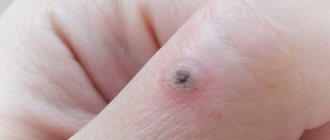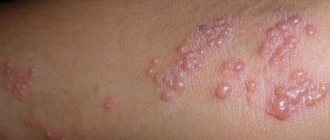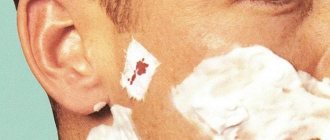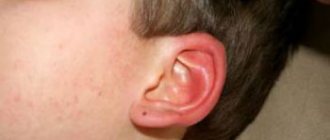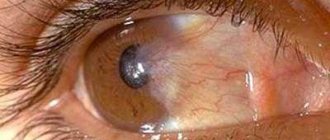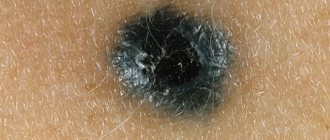When a person encounters papilloma, it always causes internal rejection. Many perceive this growth as simply an aesthetic problem, while others suffer from discomfort, especially if it appears in a hard-to-reach place. It is not surprising that a new growth on the nipple becomes a real problem, which you want to get rid of as quickly as possible. But in order not to harm yourself or aggravate the situation, you should get to know him better.
Diagnosis of breast papillomas
Papillomas that appear under the breasts or in the décolleté area can be confused by many with ordinary birthmarks. Diagnosis of growths in the breast area is made by examining the appearance of the tumor. In their color and shape, they resemble light moles, but at the same time they are attached to the skin tissue with the help of a small stalk and look like a formation above the skin.
Benign growths have a light brown tint, and their size can be completely different. They can be small, large, oblong or round, and also have completely non-standard shapes.
Most often, papillomas that appear in the chest area are localized in the following places:
- on the nipples or in a circle;
- in the ducts of the mammary gland;
- under the mammary glands, where the skin usually rubs.
Patients usually encounter external growths, but internal tumors appear less frequently. However, if a woman has a weakened immune system and HPV is activated, then papillomas can grow inside the glands.
Diagnosis and treatment methods
To determine the presence of a formation, an ultrasound examination is performed. In this way, the diagnosis is confirmed in the case when external growths appear on the nipple, aureole or surrounding skin. If you experience discomfort in the chest area, you need to get tested for HPV. Such examinations are recommended for women planning pregnancy.
Internal papillomas (cystomatomas) are also diagnosed, for which ductography and galactography are performed. To identify pathologies, a contrast agent is injected into the mammary gland, which makes it possible to more accurately determine the location of the formation.
If a papilloma appears on the nipple or surrounding tissues, the doctor in most cases recommends removal. This is due to the high risk of developing a malignant tumor. You can get rid of papillomas under the breast or on the nipple in different ways:
- Laser therapy. This method does not provoke bleeding, since damaged vessels are immediately soldered during laser exposure to tissue. At the same time, the likelihood of a scar appearing during the healing process of the skin is eliminated. When exposed to laser tissue, the risk of inflammation is reduced.
Electrocoagulation. In this case, equipment is used through which high-frequency current influences the papilloma. The main advantage of this procedure is the ability to control the depth of exposure to tissue. This reduces the likelihood of partial or incomplete removal of papilloma.
- Cryotherapy. It does not require anesthesia; during the procedure, damaged vessels are fused, which reduces the likelihood of bleeding. In this case, liquid nitrogen is used. An applicator is used to apply it. Removal of papilloma with its help is carried out quickly and practically without pain. This method has a significant drawback. The fact is that it is quite difficult to control the depth of impact of the applicator on the fabric. For this reason, you should contact a specialist with extensive experience. If you need to remove a large formation, then there is a high probability that you will have to carry out the procedure twice. This may result in a scar.
- Radio wave therapy. The method is implemented by converting electric current into radio waves. There will be no scar after using it. If the patient decides to remove the papilloma in this way, you need to know that this procedure is characterized by accuracy. This means that using this method it is possible to remove the entire formation, including the root.
- Excision with a scalpel. In this case, bleeding and pain occur, so the procedure is not performed without anesthesia. A local anesthetic is first administered.
In addition to the methods described, aggressive means are also used. These are drugs characterized by a liquid structure. Upon contact with excess tissue (papilloma), necrotic processes occur. As a result, the growth dies. It is allowed to use the cauterization method with chemical agents on an outpatient basis, as it is important to act with caution. The liquid is applied only to the papilloma; healthy tissue should be protected.
Treatment of internal formations
Intraductal growths must be removed, as they are oncogenic and can develop into a malignant tumor. It is important to remove not only the internal papilloma, but also the area of tissue around it. The procedure is carried out sequentially:
- An incision is made around the halos. In this case, it is important to get to the ducts that approach the nipple.
- Having gained access to the tumor, the specialist makes an excision, removing it.
- At the last stage, it is necessary to examine the resulting biomaterial for the presence of malignant mutations of cells and tissues.
If the question of how to remove papillomas formed on the ducts is being decided, it is necessary to choose a method that will not leave scars. Endoscopy is more suitable for this than others.
Pharmacy drugs
If papillomas are removed under the breast or on the nipple, the likelihood of recurrence or an increase in the number of formations remains high. This means that even after excision of excess tissue, a malignant tumor can still develop. To avoid this, it is necessary to simultaneously begin treatment with immunomodulatory and antiviral drugs. As a result, the body’s protective function is activated, and viral activity, on the contrary, is inhibited. There is a decrease in the intensity of cell division.
Drugs that are usually prescribed in such cases:
- Isoprinosine;
- Viferon;
- Acyclovir;
- Panavir.
All of them are characterized by different levels of effectiveness. For example, Isoprinosine gives the best results, and Panavir helps in 50% of cases. Simultaneously with taking medications, it is necessary to get rid of the tumor by excision.
However, it is not always possible to use antiviral drugs. For example, during pregnancy it is not recommended to start a course of treatment. In particular, you should not take the drugs Amiksin and Lavomax. They contribute to the development of intrauterine pathologies and deformities in the fetus. Immunostimulating therapy during pregnancy is not prohibited.
Features and reasons for appearance
Papillomas under the breasts or above the mammary glands often appear. The danger of growths is that from a benign tumor they can degenerate into malignant formations.
The following factors can provoke the appearance of a growth:
- Wearing underwear that is too tight.
- Long-term use of strong antibiotics.
- Increased sweating.
- The presence of microcracks in the skin in the nipple area during breastfeeding.
- Deficiency of useful minerals and vitamins.
- Violation of the body's hormonal levels.
- Unprotected sexual contact.
- Frequently being under stress.
A woman can also encounter a growth in cases where scratches and small wounds occur in the area of the mammary glands and on the nipple circumference, which are then not treated with an antiseptic. As a result, the virus penetrates there and begins to rapidly develop and spread.
Additional provoking factors that reduce the body’s defenses and thereby allow growths to appear even more actively on the chest are:
- diabetes;
- viral hepatitis;
- herpes;
- Infectious mononucleosis.
The presence of malignant cells also contributes to the occurrence of papillomas on the mammary glands.
Causes
About 60% of the total population of our planet are carriers of the human papillomavirus. But not everyone gets warts. Most often, people with weak immune systems suffer, since their body is not able to resist external dangers. Papillomas on the nipple can be internal or external. The internal one penetrates the mammary gland and affects the thoracic ducts from the inside. External papilloma appears as a wart on the surface of the skin.
The main reasons for this problem are as follows:
- Hormonal imbalances, for example, during pregnancy;
- Decreased immunity;
- Minor nipple injuries that can occur when feeding a baby;
- Uncomfortable, tight bra;
- Physical chest injuries;
- Poor hygiene.
The virus itself can be infected from its carrier through kissing or sexual intercourse. Infection can also occur through personal hygiene items: towels, razors. In the rice group are those who are prone to bad habits.
Types of papillomas
Growths are usually divided into the following types:
- 1) filiform warts;
- 2) flat papillomas;
- 3) vulgar neoplasms.
Filiform warts most often appear under the breasts, where the skin is subject to friction and increased sweating. New growths on the skin of a flat shape can be noticed just in the nipple area. But vulgar papillomas rarely affect the mammary glands.
The number of growths formed is associated with immunity. Therefore, if the body is weakened, there are more papillomas. During pregnancy, many girls may also find formations in their décolleté area.
How to get rid of papillomas that appear on the chest
The human body is a clearly tuned mechanism, so any new growths on the skin indicate the beginning of problems. Many women often develop papillomas on the nipples and under the breasts, causing unpleasant discomfort. In this brief review, we will tell you in detail about the causes of the disease and how to effectively get rid of it.
Papilloma on the chest, an extremely unpleasant disease
Using someone else's clothes, linen or towels becomes a factor due to which the infection penetrates inside the body.
Methods for removing growths and hardware techniques
Trying to fight growths at home on your own is extremely difficult. It is better to trust a professional who, after diagnosis, will offer the most effective and acceptable method of removal. Especially if there are many papillomas on the chest and they occupy a large area.
When it comes to benign education, a specialist can suggest the following methods:
- surgical excision - performed above and below the breast;
- removal using liquid nitrogen;
- laser exposure;
- Diathermocoagulation – most often used to remove filamentous papillomas. The procedure is based on the impact of high-frequency current, after which a slightly noticeable scar may remain;
- the use of medications - antiviral therapy.
Most often, patients prefer to get rid of papillomas using a laser. And this method is one of the fastest, most effective and painless. After removal there are no noticeable scars or marks left. Moreover, with the help of laser exposure it is possible to get rid of growths located in the ducts and the outermost layers of the mammary gland.
To eliminate tumors that have appeared under the breast, some experts recommend the use of surgery or radiosurgery. The latter method involves the use of high-power ionizing radiation. This is also a painless method that allows you to remove absolutely all growths without leaving any traces. More often, this method is prescribed after an examination by a mammologist, since the formations no longer return. Malignant growths are removed without fail, which is revealed during research into the nature of the growths.
Symptoms and diagnosis
External nipple papilloma is a soft wart that stands out on the surface of the skin. It can be seen with the naked eye. The growths can be light or almost black. If the papilloma is located in the ducts, then on your own it can only be detected by palpation (palpation with your hands).
The main symptom of internal papilloma is the appearance. The sensitivity of the nipple increases significantly. When you touch it, you may feel a burning or tingling sensation.
A mammologist can accurately determine the diagnosis after an ultrasound of the breast.
The papilloma can be located directly on the nipple or on the halo (pigmented area around). If there are many tumors, it is called papillomatosis.
An effective way to get rid of papilloma is its surgical removal. Under no circumstances should you try to remove the growth yourself at home. In general, if you have papillomas, it is not recommended to do anything on your own, since if taken incorrectly, a completely harmless wart can transform into a cancerous tumor. If bleeding from a tumor on the chest is accidentally caused, it must be stopped by applying a sterile napkin for several minutes.
Traditional therapy and folk medicine
You can fight papillomas on the chest not only through removal, but also with the help of medicinal ointments that can stop the development of the virus and destroy the growth. The most commonly prescribed drugs are:
- means – “Viferon”, “Betadine”, “Cryopharma”;
- ointments – oxolinic, salicylic, “Stefalin”, “Isoprinosine”;
- cream - "Panavir".
All these medications have antiviral and antimicrobial effects. At the same time, the healing process is accelerated, and the affected tissues are disinfected. Ointments, creams and various patches can help with formations that are located outside the mammary gland. And internal growths must be treated through complex therapy.
To speed up the healing process and enhance the effectiveness of treatment, you can use traditional medicine recipes. To do this, a woman needs to make compresses based on crushed garlic and applications with a vinegar solution. It is necessary to lubricate each growth with celandine juice.
Treatment of the disease
Today, nipple cancer is considered a curable disease, of course, provided that it is diagnosed in time and adequate treatment is started immediately. Combined treatment methods make it possible to get rid of this dangerous disease if the process has not yet spread to other organs.
Be sure to read: Treatment of a spinal tumor
Treatment may be as follows:
- Removal of the tumor. At the initial stage of the disease, when the tumor has not yet grown deep into the mammary gland, a resection of the mammary gland is performed with possible further plastic surgery of the areola and nipple. If the stage of the disease does not allow such an operation, then the mammary gland is completely removed along with the lymph nodes. If necessary (if the tumor has grown into the muscles), the damaged muscle layer is also removed.
- Chemotherapy. This procedure is carried out in two courses - before and after surgery. The first course is needed so that the formation stops growing and shrinks, and the second is necessary to remove cancer cells that may have remained after surgery.
- Radiation therapy. This type of treatment is almost always combined with chemotherapy when the disease is severely spread, and it is also carried out before and after surgery. The rays destroy cancer cells, which greatly reduces the possibility of relapse.
- At the moment, a new direction has emerged in oncology - immunotherapy. Cancer cells are exposed to non-toxic drugs. “Golden bullets” are the so-called monoclonal antibodies that can find malignant cells in the body and destroy them.
What is the danger of papillomas in the chest area?
The danger of growths that appear in the area and inside the mammary glands lies not only in the unpleasant symptoms, but also in their ability to degenerate into malignant formations.
Papillomas that appear inside the ducts cause unpleasant and painful sensations, itching and burning. Especially if a woman touches her mammary glands. In this case, discharge from the breast may appear. Also, internal growths often contribute to an increase in body temperature. And if these signs are discovered during a personal examination of the breast, you should immediately consult a doctor and undergo a full examination.
The danger of formations lies in the fact that it is precisely this localization of papillomas that most often leads to cancer. It is difficult to examine and establish this on your own, but by examining an oncologist and going through the necessary diagnostic methods, it will be possible to detect the presence of cancer cells in time.
Pointed papillomas
During sexual intercourse, a virus enters the body and as a result, after some time, genital warts (a type of papillomas) form on the human skin. In some clinical cases, genital warts may eventually take the form of blisters with fluid. Later they burst and emit a sharp, unpleasant odor.
Of all the types of papillomas, it is the pointed type of formations that is the most dangerous. In most cases, genital warts are diagnosed as oncogenic - they can turn from a benign tumor into a malignant one. In addition, genital warts significantly worsen a person’s quality of life - they interfere with walking and sexual intercourse. Most often, removal of genital warts is carried out using liquid nitrogen.
Features of treatment of papillomas on the chest during pregnancy
If during pregnancy a woman encounters single formations in the breast area, then this does not pose any threat to her health.
But if too many papillomas begin to appear on the mammary glands, then we are talking about very weak immunity. However, it is not recommended to remove these tumors using electrocoagulation or laser. Especially when it comes to early pregnancy. Any stress during this period (the procedure for removing papillomas can provoke it) harms both the health and emotional state of the expectant mother.
Conservative treatment of growths while expecting a baby can be prescribed from 28 weeks. It is better to use hardware removal of papillomas after childbirth.
Papillomas on the chest during pregnancy
The appearance of papillomas on the nipple halo or directly on the nipple is observed in expectant mothers. After all, during pregnancy, hormonal changes in the body are inevitable, which can lead to activation of the virus and its manifestation on the chest through the appearance of papillomas.
Typically, pregnancy is a contraindication to the use of most antiviral drugs, especially those such as Amixin and Lavomax, which can cause serious birth defects in the fetus. Therapeutic measures can only begin after the birth of the child. The danger of self-medication during pregnancy is especially great. It is interesting that after the birth of a child, papillomas often disappear on their own. This can be explained by the same hormonal disorders.
Prevention
To ensure that you no longer encounter this problem after getting rid of papillomas on the chest, you must adhere to the following recommendations:
- regularly examine the mammary glands, especially if a woman feels unpleasant symptoms in this area;
- the diet should consist of fruits and vegetables rich in polyphenols and organic acids;
- once every six months you should take complexes that strengthen the immune system;
- if growths begin to appear on the skin, you should immediately see a doctor;
- try to avoid excessive sweating in the chest area and avoid wearing tight underwear.
Compliance with all the rules in everyday life will help to avoid the reappearance of tumors on the chest and thereby reduce the risk of recurrent papillomas.
Antiviral drugs and immunomodulators
Removal of the tumor by physical method is carried out on the 3-5th day of taking the immunomodulatory drug.
The main means for correcting immunity when getting rid of warts are interferon inducers (Isoprinosine, Kagocel, etc.) and human interferon preparations (Viferon, Genferon, etc.)
Regimen for taking immunomodulators and antiviral drugs in the treatment of breast papillomas
In case of extensive damage to the skin, antiviral drugs for systemic use (Panavir) are prescribed. Also, according to the doctor’s decision, such products can be used topically in the form of a gel or cream (Panavir, Vartotsid, Aldara). Local antiviral medications are not used during pregnancy and in persons under 18 years of age.
For the speedy healing of affected lesions after removal, it is recommended not to take a general bath, not to sunbathe, and to change bandages regularly. After treating the wound and changing the bandage, you should thoroughly wash your hands with soap to prevent the spread of the virus to healthy areas of the skin.
Possible causes of breast tightness
Breast cyst Fibroadenoma Infection Trauma
So, if you notice that...
BREASTS INCREASE
1. You are gaining weight
After puberty, breasts grow as the rest of the body grows. Why does my weight increase? You may eat more, exercise less, sleep little, or live under stress. Plus or minus a kilogram is natural. If you gain more weight, your risk of getting cancer increases.
2. You are expecting your period, have started taking oral contraceptives or are pregnant
Hormones affect breast size. If both breasts are enlarged, there is nothing to worry about.
BREASTS ARE SMALLER
3. You are losing weight
Breasts are made up of fat, so if you are losing weight, they will be the first body part you notice. If your weight and breasts are decreasing for no apparent reason, you should see a doctor. After all, it could be hyperthyroidism or another disease.
4. New menstrual cycle
If the breasts increase before menstruation, it means that after it the swelling will go away and they will decrease. There is no reason to worry.
ONE BREAST IS BIGGER THAN THE OTHER
5. Nothing special
Breasts are not symmetrical, so if they have always been different sizes and shapes, that's okay.
6. Breast cancer
If the shape of one breast is changing, it's time to get checked for breast cancer.
IRRITATION TO THE SKIN UNDER THE BREASTS
7. Allergies
This happens when your bra wires are made of nickel, the soap didn't wash off after swimming, or you wore a sweater that irritates your skin. Hydrocortisone ointment will help you. If the irritation does not go away after a few days, see a doctor.
8. Intertriginous dermatitis
Or diaper rash. Very often in summer the skin under the breasts becomes chafed and inflamed. An antibiotic, steroid or hydrocortisone ointment will relieve the irritation, and a properly fitted bra will support your breasts and prevent recurrence.
9. The linen is no longer fresh.
Infrequent washing actually preserves the laundry, but bacteria or fungi can settle in it. The skin under the breasts sweats a lot and this is very beneficial for them.
YOU HAVE NOTICEABLE STRETCH MARKS
10. Your weight is fluctuating.
As your weight fluctuates, your breasts grow and shrink. This causes stretch marks. This often happens after pregnancy and in women with thin, inelastic skin.
VERY DARK OR LIGHT NIPPLES
11. Nothing special
No, it's not cancer. Each woman's nipples are colored differently. The main thing is that it is symmetrical.
VERY LARGE OR SMALL NIPPLES
12. Nothing special
Our bodies are simply different. If they are symmetrical, there is no problem.
BUBBLES ON AREOLAS
13. Nothing special
Breasts are intended for feeding babies. These tubercles are the exits of the milk ducts. Sometimes they get a little bigger, so if there are small bumps surrounding your nipple, you're fine.
ONE LARGE BUMPLE ON THE AREOLA
14. Benign cyst or malignant neoplasm
Get tested as soon as possible to find out if there is any cause for concern.
HAIR AROUND THE NIPPLE
15. Polycystic ovary syndrome
If you have started to grow hair around your nipple, your testosterone levels may have increased due to PCOS. Other symptoms include acne and irregular periods. Polycystic disease can lead to infertility, so you should see a doctor.
NIPPLES ITCH
16. Shampoo or soap residue irritates the skin.
Rinse your skin with water and apply hydrocortisone ointment.
17. Allergy to clothes
This could be a reaction to the dye in a new bra or wool sweater. Apply hydrocortisone ointment to your nipples and change your clothes.
18. A new cycle will begin soon
Sometimes hormonal changes cause itching.
19. Paget's disease
Or breast cancer, a very rare disease. Its symptoms are itchy nipples and areolas, flaky skin, a flattened nipple, and yellow or bloody nipple discharge. See a doctor immediately.
PAIN AND LAMPS IN THE CHEST
20. A new cycle will begin soon
Depending on the phase of the cycle, the structure and sensitivity of the breast may change. You should see a doctor. One consolation is that if you have bumps but no pain, then most likely it is not a tumor.
21. Too much caffeine
Caffeine causes chest pain for some people, so just start drinking less coffee, tea and soda and the problem will go away.
WHITE CLOUDY DISCHARGE FROM NIPPLES
22. Something stimulates milk production
Breasts are needed to feed babies. If the discharge looks like milk, something may be stimulating your milk production, even if you are not pregnant or caring for a small baby. The doctor will choose a medicine for you.
23. Side effect of antidepressants or antipsychotics
Some medications increase levels of prolactin, a hormone that stimulates milk production. In most cases, this is done safely, although it is unpleasant.
OTHER DISCHARGES FROM THE NIPLE
24. Benign neoplasm
Known as papilloma. You should see a doctor.
NIPPLES HARD
25. You're excited
If your nipples are symmetrical but firm, there is nothing to worry about. The muscles around the nipple simply contracted. This is usually related to sex.
26. You are cold
If it's not about sex, then the simplest explanation is cold. Just stay warm.
Inverted Nipple OR Dimples in the Nipple or BREAST
27. Breast cancer
Any dents could be a sign of cancer. You should see a doctor URGENTLY.
LAMP IN THE CHEST
28. Everything is fine with you
Now it’s just another phase of the cycle when the breasts become denser. This is fine. Breast lumps that could mean something serious can only be detected with a mammogram.
VEINS VISIBLE THROUGH THE SKIN
29. Risk of skin cancer
Fair skin is usually pale and translucent. If so, you are at high risk of sunburn, but as long as you don't overextend yourself and use sunscreen, there won't be any serious problems.
BREASTS LOOK LIKE ORANGES
30. Breast cancer
If your smooth breasts suddenly become uneven like an orange peel, and your areolas and nipples become hard, it may be cancer. You should see a doctor URGENTLY.
BUNE ON THE CHEST
31. Benign cyst
If it is round and smooth and you can move it, it may be a benign cyst filled with fluid. It's not a tumor. You should see a doctor.
32. Breast cancer
Most often, pain and growths in the chest are the result of hormones. Every time you encounter them, the question arises: is it cancer or could it become cancer? Only the doctor will answer.
The pimples on a woman’s nipples are rudimentary glands, the functions of which have not yet been studied. They often have a negative impact on the appearance of the breasts, and can also bring significant discomfort to the woman. How normal is this process and why does this happen? There can be a lot of reasons: from standard changes in hormonal levels to an infectious disease. These are the ones that need to be examined in more detail.
Preventive precautions
In order to avoid such tumors on the nipples and skin, experts recommend constantly maintaining and strengthening your immunity. This way the body will fight the disease on its own and will not allow it to activate. In addition, all hygiene rules must be observed.
You should constantly feel your breasts, at least once a month. If during such a procedure you find a formation, do not hesitate to go to the doctor. There is no need to self-medicate, as this can lead to more serious consequences. Then you will have to spend a lot of effort and money on recovery.
Every day, scientists are developing new methods of treating this unpleasant disease. They are trying to develop against this virus, but, unfortunately, at the moment everything is to no avail. Any pregnant girl should know that using protective equipment during sexual intercourse does not protect against infection. Expectant mothers are advised to carefully monitor their weight and wear loose, seamless underwear.
Mar 31, 2020 Violetta Lekar
Lump in the chest Lump in the chest
Lumps are localized lumps, lumps, lumps, bumps, or protrusions in the breast. A lump in the breast can appear in both sexes and all ages. In women, this usually immediately triggers a fear of breast cancer, but many breast lumps are, fortunately, benign and can be successfully treated - such as infections, injuries, fibroadenomas, cysts, or fibrocystic breast disease. However, no breast lump can be called benign until it has been evaluated by a doctor.
Lumps, bumps, and hard formations in the nipple area and under the nipple in teenage boys may appear during puberty (12, 13, 14 years) and persist throughout the year; the nipples may be swollen and painful to the touch. This is a normal physiological state during adolescence. This condition is called physiological gynecomastia and it occurs in almost 65% of adolescents.
Before a teenager reaches 10 years of age, if gynecomastia is suspected, it is necessary to undergo an endocrinological examination. 10 years is a bit early for teenage physiological gynecomastia. To clarify the condition of the gland, it is necessary to do an ultrasound.
If lumps and pain persist or appear in men over 18 years of age, an ultrasound of the breast should be performed and the size of the gland should be recorded so that it is possible to monitor the dynamics and take hormone tests. If the glands are aesthetically disturbed, surgery may be performed.

